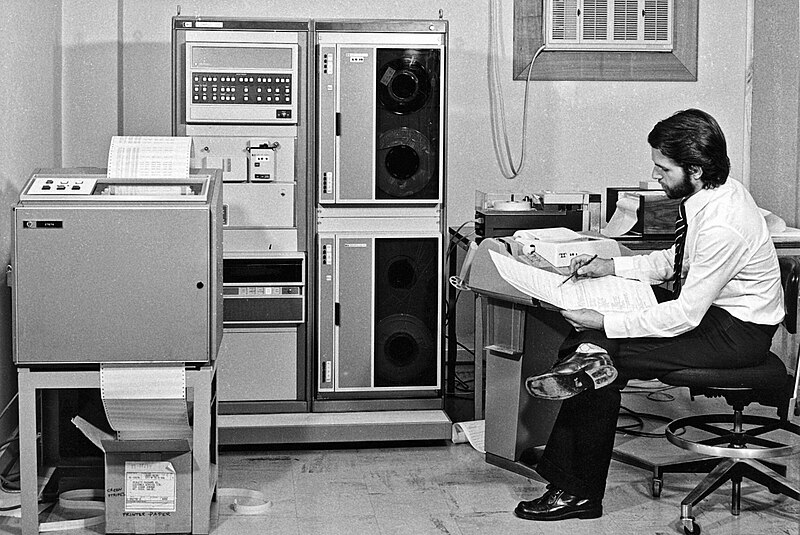Recall the riddle explained in previous article
(SCREENFREE): Our goal is to achieve: Ubiquitous Computing That's Nowhere To Be
Seen. This dream might sound like an impossible contradiction. How can
computer-use be everywhere, but also be separate from a computer? How can we
use a computer, without, well, being at a computer?
Excavating the Screenless Past
 Teleprinter Computing | 1974 Santiago, Hewlett-Packard 2000F
Teleprinter Computing | 1974 Santiago, Hewlett-Packard 2000F
When you imagine computers from the 1950s and 1960s, you might first think about the black & white photos in history books of giant contraptions filled with levers and vacuum-tubes (50s), or massive gray boxes covered with blinking lights (60s and 70s). During the 70s, scientists discovered new ways to design transistors at microscopic sizes. Thanks to this, computers are simply much better. Computers are now billions of times quicker, cheaper, and smaller.
The modern idea of a "video display" also took over, first with text-based "virtual terminals", and later with the graphical "WIMP" paradigm. In 1973, developers at Xerox Alto created this first WIMP interface, an acronym that lists the core elements still in use today: Windows, Icons, Menus, and Pointers. Apple and Microsoft quickly copied the design for Mac and Windows respectively, and decades later smartphones would get something similar, except with a touch screen as the pointer interface.
And yet, as important as these developments are, the solution lies further in the past. Before screens took over, people would code, study, and use computers off-line. You might think that's obvious (the Internet only became popular in the 90s, after all). However, back then, it meant truly off-line. People could compose software or write computer games "off-line" by referencing books and writing the code onto a deck of so-called "punch cards", called that due to the patterns punched onto each card, that worked a little like QR codes. To run it on a computer, a deck of cards was "fed in" to a computer, which would "spit out" a reply via a printer.
The switch to electronic file systems and displays must have been a very exciting thing to witness. Soon, instead of using a physical documents, physical folders, and physical card decks of code, you could write software on a virtual computer desktop, using a virtual computer folder of electronic files. All the trappings of physical computing could be mapped into electronic file systems. The WIMP model let us arrange windows to simulate coding on one side, while flipping through computer books on the other. Getting help "online" (i.e. from a "Help" menu) meant answers could appear as soon as we typed, instead of having to thumb through a book.
Before this, coding was actually physically hands-on and off-grid. Running the code was the only part of the process that involved the computer. After running the code, it was back to hands-on and off-grid again, except with reading, scrutinizing, and annotating the paper. The computer acted kind of like an oracle, receiving input from the real world, and then materializing it's response as a physical contribution back. This means the computer users spend very little time actually, well, using the computer. Computer users spent more of their time off-line instead.
The Answer to the Riddle
 Census Office Worker | 1950s United States Census, IBM Type 016
Census Office Worker | 1950s United States Census, IBM Type 016
Today, off-line time is exactly what we're chasing, and being sucked into a screen is exactly the thing we are trying to avoid. We may have found a solution in 1973 to our interface paradox. This means that reading books, writing code by hand, and analyzing code output is a way to "use a computer without actually being at a computer."
However, you might also think that the 1973 screenless past, sounds, well, pretty terrible! Writing code by hand, surrounded by piled up reference books sounds about as fun as overtime at the office or cramming for a test! When we use our phones today, we are trying to relax, not get a degree in computer science. But don't worry: We aren't suggesting everyone just go back to 1973 teleprinters or coding FORTRAN with punch-cards. The moral of our history lesson here is that it shows that, at the very least, an off-line computer world can exist. We need to build one that works for us.
People will need to be able to do the same things they did before with the same level of ease. How can we use computers for reading entertainment or news, while staying offline? How can we create and manage media without a screen, while keeping the convenience of modern word processing? How can we play action-based computer games, or real-time strategy simulations, without a screen? How can we avoid sacrificing the digital convenience of full-text search of Wikipedia?
Hidden in this old paradigm is part of the answer. We need to dig it up. That means that our project at BDI is one part computer science, one part archaeology. We need to excavate a hidden technological past from 1973, and then combine it with the expectations of 2023.
Continue with Part 3: OREGON TRAIL, ON PRINT
